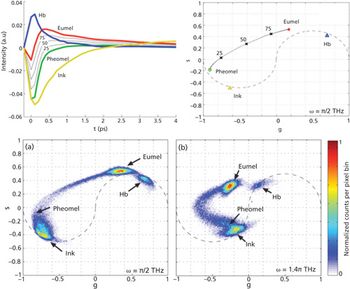
- Spectroscopy-01-01-2010
- Volume 0
- Issue 0
Group Theory and Symmetry, Part II: Groups
In the previous installment of this column, David Ball introduced the five types of symmetry elements that are important in physical science. Here, he discuss why it’s called "group" theory in the first place.
As I mentioned in the previous column (1), no random combination of symmetry elements exists for any real objects, including atoms and molecules. Only certain combinations are possible, and while there may be an infinite number of possible combinations, only a small fraction of them are relevant to existing atoms and molecules. We called these combinations point groups. Why "groups"? What follows might not be perfectly proper mathematically, but it should conform to the applications of group theory to spectroscopy and other physical sciences.
David W. Ball
Definition of a Group
There are several definitions of a mathematical group. Generally speaking, a group is a set of elements with a defined operation in which a combination of two elements generates a third element that is also a member of the group. There are several types of groups, but for molecular applications, we usually deal with what can be called matrix symmetry groups: "symmetry" because it relates to the invariant shape of an object, and "matrix" because the operations can be expressed using matrix multiplication, a topic you may want to review before proceeding!
To be a group, the set of elements must satisfy four criteria:
- The combination of any two elements must be equivalent to a single element that is also a member of the group. This requirement is called closure.
- For any three elements a, b, and c, the following requirement must hold: (ab)c = a(bc). This requirement is called associativity, and is indeed exactly the same as the associative law we were taught in algebra class.
- There must be an identity element, I, in every group such that for any random element a in the group, aI = Ia = a.
- For each element a there must be an inverse element a–1 so that aa–1 = a–1 a = I, the identity element. An element can be its own inverse.
If a set of elements with an associated operation satisfies these four requirements, they constitute a group. Note that there is no requirement for commutation, that is, the combination ab might not necessarily be equal to ba. If this is so, the group is called an abelian group (after Norwegian mathematician Niels Abel), but there is no requirement that a group be abelian.
Figure 1
The classic example of a group is the set of integers {...–3, –2, –1, 0, 1, 2, 3, ...} with the operation being addition. The addition of any two integers is an integer (closure), (a + b) + c = a + (b + c) for any three integers (associativity), zero is part of the set (identity), and there is an inverse such that for any integer a there is an inverse –a such that a + (–a) equals zero, the identity (inverse). Integers are also a group with respect to the operation of subtraction, but not with respect to the operations of multiplication or division (can you verify that yourself? I'll give you a hint: think about the inverse criterion).
Figure 2
Groups and Symmetry Operations
The symmetry operations in a point group fit the definition of a mathematical group; hence the term point group. We can demonstrate that easily by considering the symmetry elements of a shape having a C2v point group symmetry, as illustrated by the arch in Figure 1. (We introduced this shape in part I of this series [1].) Let's consider the requirements of a group out of order. First, there is the identity element, E. Second, note the E is its own inverse; the C2 operation can be undone by performing a C2 operation one more time to return all points on the shape to their original spots, so C2 is its own inverse; and each reflection operation can be performed once again to return all points to their original positions, so both σ planes of symmetry are also their own inverses. Thus, the group of symmetry elements contains the inverse of each operation.
Figure 3
We can demonstrate closure by performing each possible combination of two symmetry operations and, by following a single point on the shape, determine which one symmetry operation the combination is the equivalent of. For example, suppose we perform a C2 operation followed by a σv operation. These two operations are illustrated in Figure 2, where a single point has been marked so we can determine which one symmetry operation is equivalent to the combination. First, the C2 operation spins the arch around by 180°, putting the blue spot in a new position. Then, reflecting the arch through the plane of the page moves the blue spot to a second new position. But, hopefully it is clear in Figure 3 that moving the blue spot to its final position could be obtained by simply performing a single symmetry operation, the reflection of the archway through the plane that is perpendicular to the page, the plane labeled σv'. One way of writing this concisely is
We can do this for every pair of symmetry operations in the C2v point group. Table I is a concise summary of all 16 possibilities. Note that all possible combinations of the symmetry operations is equivalent to a single symmetry operation of the point group. As such, this set of operations satisfies the closure requirement of groups.
Table I: Results of performing two symmetry operations of C2v in succession
To demonstrate associativity, we need to show that for any three symmetry operations in the group, (ab)c = a(bc). Here, Table I can help us because it gives us the equivalent of any combination of two symmetry operations. For example, consider
Is this equality true? We can see in Table I that C2σv' is equivalent to σv, while σv' σv is the same as C2. Substituting for the terms in parentheses, the above equality becomes
Again, using Table I, we see that σv σv is equal to E, while C2C2 is equal to E. Substituting once more:
Thus, we have demonstrated that, in the case of C2, σv', and σv, these three symmetry elements are associative. Ideally, we would have to demonstrate that every possible combination of three random symmetry operations satisfies the associativity relationship, but you can do that on your own time. Take my word for it, they do satisfy this requirement. Therefore, we have demonstrated that the set of symmetry operations of this point group are indeed a mathematical group.
With this particular point group, it is relatively easy to demonstrate that it is a mathematical group. Consider the triangular pyramid in Figure 3. It obviously has threefold symmetry, so we can immediately list identity E, a C3 rotational axis, and three vertical planes of symmetry for this shape.
However, these five symmetry elements are not enough because it can be shown that closure cannot be achieved. A symmetry element is missing. Recall from part I of this series, however, that some rotational axes can be performed more than once and the original shape is regenerated but the points of the shape have not returned to their original positions. Thus, that multiple rotation is also a symmetry element, a separate symmetry element, that must be included with the other symmetry elements of the group. In the case of our pyramid, not only does a rotation of 1/3 of a circle regenerate the same shape (a C3 axis), but rotation of 2/3 of a circle regenerates the same shape. Because rotation by 2/3 of a circle is the equivalent of performing 1/3 of a full rotation twice, this new symmetry element is referred to as a C32 axis and it must be included as a separate symmetry element for the point group. (Rotation by 3/3 of a circle is the equivalent of not moving the shape at all, so this corresponds to the identity element E and is not included as a separate symmetry element.) So, the set {E, C3, C32 , σv, σv', σv"} now represents a group referred to as the C3v point group.
Point groups for all important point groups used in physical sciences are readily available in many physical chemistry and inorganic chemistry texts, as well as specialty texts on group theory.
Matrix Representation of Symmetry Elements
I mentioned earlier that we use the word "matrix" to describe the type of group theory we use in physical science. Here, I'll try to explain why.
Consider the vector in Figure 4, going to the point (3, 4) in the xy plane. If we consider the y axis to be a plane of reflection, then this vector can be reflected to the opposite quadrant, as shown in Figure 4. Now the vector is pointing to the position (–3, 4) – the x value has changed sign.
Figure 4
We can reproduce this operation using matrix algebra. If the original vector can be represented as the column matrix
then the reflection operation can be written as the following matrix multiplication:
(You may have to review the rules for matrix multiplication to follow this.) Thus, we are positing that the reflection operation can be represented by the 2×2 matrix:
In this example, we are considering just a single point — this point does not have the symmetry element s. However, consider an object that does have s as a symmetry element, as shown in Figure 5. If you take every point on that diamond and multiply it by the 2 × 2 matrix representation of s, you will reproduce the diamond shape exactly, thus confirming that the diamond has a reflection plane of symmetry at the y axis. As such, the 2 × 2 matrix above is a legitimate expression of a reflection plane of symmetry. Symmetry elements can be expressed as matrices, and their operations can be represented by matrix algebra.
Figure 5
We must use 3 × 3 matrices to represent symmetry elements, because real objects exist in three-dimensional space. Table II gives the general matrices for the five different types of symmetry elements introduced in part I of this series. To perform a symmetry operation, each point on a shape is expressed as a column matrix and is multiplied by the appropriate 3 × 3 matrix.
Table II: General matrices for the five types of symmetry elements
Each matrix in Table II is called a representation of the symmetry element. One goal in group theory is to construct the simplest representation of the symmetry elements so as to minimize the amount of information needed to express the symmetry of an object and to simplify symmetry manipulations. In the next installment of this column, we will look more closely at representations of the symmetry elements and explore how we can simplify them for ease of use.
David W. Ball is a professor of chemistry at Cleveland State University in Ohio. Many of his "Baseline" columns have been reprinted in book form by SPIE Press as The Basics of Spectroscopy, available through the SPIE Web Bookstore at
References
(1) D.W. Ball, Spectroscopy 24(12), 63 (2009).
Articles in this issue
almost 16 years ago
How Optical Advances Helped Deliver the Promise of Miniature Spectrometersalmost 16 years ago
Market Profile: Magnetic Sector ICP-MSalmost 16 years ago
Mass Spectral Libraries: The Next Generationalmost 16 years ago
Products Resourcesalmost 16 years ago
Calendar of Eventsalmost 16 years ago
IFPAC 2010almost 16 years ago
Vol 25 No 1 Spectroscopy January 2010 Regular Issue PDFNewsletter
Get essential updates on the latest spectroscopy technologies, regulatory standards, and best practices—subscribe today to Spectroscopy.




